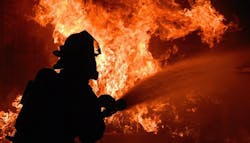MBMA works with Underwriter’s Laboratory to fire test metal buildings
One of the reasons metal building systems are so efficient and versatile is the collective commitment of the industry to improving their product. Acting together through the industry’s major association, the Metal Building Manufacturers Association (MBMA), companies across the country conduct numerous initiatives to advance the performance, utility, and affordability of metal building systems. Teamwork aids progression. Every metal building system benefits from this industry-wide support.
From the many initiatives taken in the name of metal building progress, fire testing is a major one. The MBMA conducts comprehensive fire tests on metal buildings, and some people may find this odd, because the major component of any metal building system is steel—which is non-combustible. However, some elements of metal building construction, such as insulation or wall finishes, could be flammable. That’s why fire testing is essential.
The fire safety of metal building systems is just as important as any other type of building system. And the ability of a metal building to prevent or slow down the spread of fire is not just about protecting the structure. First and foremost, safety design is aimed at protecting the survival and well being of live occupants. Fire safety in metal buildings is about saving lives. That’s why MBMA takes fire testing very seriously.
To fire test metal buildings, , one of the most established and highly respected testing services in the nation. Together, they conduct tests according to widely accepted standards (such as ASTM E-119 Standard Test Methods for Fire Tests of Building Construction and Materials). Testing, which takes place is an independent third-party lab, involves building full-scale wall or roof-assemblies, and then burning them in a furnace under laboratory conditions for several hours. The results prove the performance of the chosen design options, and are later distributed across the industry.
In a recent MBMA article, 5 Things to Know About Metal Buildings & Fire Ratings, test results of many different fire-rated assemblies for roofs, walls, columns, and joints are discussed. Beyond describing the outcome of the tests, the article aims at product knowledge. It’s meant to help builders choose their products wisely before buying materials.
The article describes the fire testing of two newly approved wall assemblies. These 1-hour and 2-hour exterior wall assemblies include the metal wall framing, steel furring, gypsum board, exterior metal wall panels, and insulation. The assemblies are designed to maximize the span of the girts to allow room for door framing. Also, the wall assemblies are constructed with attention to energy code requirements to ensure they could meet the ever-changing terms.
Recent changes in energy codes mandate thicker insulation in walls and roofs to improve efficiency, and sometimes require the specification of exterior rigid board (foam) insulation. These changes impact fire safety.
The most widely used insulating material, fiberglass, has high fire resistance. While foam insulation, which is strongly favored for some insulating applications, may have very different properties in terms of combustibility, flame spread, and smoke developed.
The tests included both fiberglass and rigid board (foam) insulation. Designs with both types of insulation achieved fire resistive wall assembly ratings and are now designated as UL Design Nos. W404 and W413 (1- and 2-hour exterior wall fire ratings, respectively).
That means builders can trust fiberglass and rigid board insulation, in case of fire, to help protect the people inside and the building itself.
Overall, these combined and ongoing efforts by the industry don’t only mean added safety, but they also help keep metal building systems ahead of the curve. As construction practices and building codes continue to evolve, so do metal buildings. MBMA and Underwriter’s Laboratory help make sure of it, and that’s good business.

